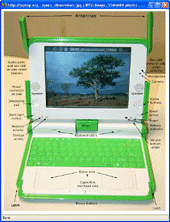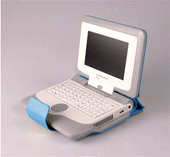 By now everyone on the planet has heard of Nicholas Negroponte’s One Laptop Per Child Project (OLPC), which aims to “provide children around the world with new opportunities to explore, experiment and express themselves” by providing children in developing countries worldwide with a laptop. This ambitious venture has produced an inexpensive and extremely durable machine which will be sold to governments around the world and distributed to impoverished children. The laptop, called the XO, is currently in its final beta phase and is being prepped for mass production. What you may not know, however, is that the XO is not the only inexpensive computer being produced for this purpose. There is competition. Intel has been selling its version of the “cheap laptop” since March for $225. The company recently joined OLPC in an effort to maximize the benefits of this laptop development around the world. Vice President and director of corporate affairs at Intel Will Swope stated,
By now everyone on the planet has heard of Nicholas Negroponte’s One Laptop Per Child Project (OLPC), which aims to “provide children around the world with new opportunities to explore, experiment and express themselves” by providing children in developing countries worldwide with a laptop. This ambitious venture has produced an inexpensive and extremely durable machine which will be sold to governments around the world and distributed to impoverished children. The laptop, called the XO, is currently in its final beta phase and is being prepped for mass production. What you may not know, however, is that the XO is not the only inexpensive computer being produced for this purpose. There is competition. Intel has been selling its version of the “cheap laptop” since March for $225. The company recently joined OLPC in an effort to maximize the benefits of this laptop development around the world. Vice President and director of corporate affairs at Intel Will Swope stated,
“Our role here is one of how do we have the biggest impact on education and on children around the world?” he said. The chipmaker has spent more than $1 billion in education initiatives since its founding, and over the last five to six years has been investing annually around $100 million on such projects. “How could we make that more impactful and reach more children?” Swope asked. The answer, he said, was to join OLPC.
Despite its collaboration with OLPC, Intel will continue producing and selling its Classmate PC to governments, leaving it up to countries to decide which laptop, the XO or the Classmate, will best suit its children. While the general concepts of the laptops overlap, variations in design, structure and applications make each laptop best suited for different environments.
 In addition to these education-focused laptops, several other corporations are developing cheap versions of computers, not for philanthropy’s sake, but mostly to get into the mix of this potentially profitable industry. Blogger Rory Reid at CNET’s CRAVE makes the point that most people’s day-to-day “computing” is relatively simple, possibly justifying the purchase of “cheap” computers:
In addition to these education-focused laptops, several other corporations are developing cheap versions of computers, not for philanthropy’s sake, but mostly to get into the mix of this potentially profitable industry. Blogger Rory Reid at CNET’s CRAVE makes the point that most people’s day-to-day “computing” is relatively simple, possibly justifying the purchase of “cheap” computers:
“Think about your own PC usage–does it honestly include anything more demanding than Facebook stalking, laughing at idiots on YouTube or hitting the digg button underneath the latest lolcat? Can you justify spending $4,000 when a machine costing $100 pounds will do exactly the same thing? Crave thinks the world can learn a lot from the XO, the ClassMate PC and its ilk. These devices could change the computing world as we know it. And despite its makers saying it’s exclusive to the developing world, the XO absolutely should be brought to the West.”
With this in mind, other companies have begun developing and selling inexpensive versions of computers. After doing some quick research, I found Sweden’s Medson Celebrity for $150, the Zonbu (from Silicon Valley) for $99, and the Asus Eee PC 701 (“Easy to learn, easy to work, easy to play”) for $269. Where the XO and the Classmate PC focus their efforts on education, the Zonbu (a desktop–with no monitor!) seems to be going after the title for “greenest” computer–it uses no fans, 1/10 the power of a typical desktop, and is carbon-neutral. I also found the Longmeng laptop (from the Chinese Institute of Computing Technology) for $131, but I couldn’t find much on this besides what is on Wikipedia. So take this info with the proverbial grain(s) of salt. Anyway, all of these laptops are pretty different. I think the best way to express their features is in chart form (click for full size version):
Basically what we have here is a whole slew of computers being built for absurdly low prices. Some, like the XO and Classmate PC are being built as rugged, durable, and easy-to-use models that will be used out in the jungle, desert, and other rough-and-tumble areas. Others, like the Asus Eee, Zonbu, and the Medson Celebrity represent a push toward simpler and cheaper technology for everyday people. It will be interesting to see how successful these models are, in both underdeveloped areas and in countries like the US. With general trends here in the States pointing toward “bigger+fancier=better”, I’m curious to see how many people out there would actually opt to buy a cheap laptop. The benefits for the education system are obvious, but are these tools everyday people or businesses would use? Who knows.
Related Links:
BBC Breakdown of the XO
Reviews of the Zonbu (especially the Gizmodo Review )
[Poll=13]
Sign up today to have our latest posts delivered straight to your inbox.